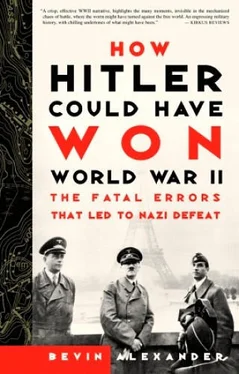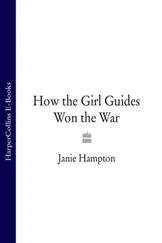p. 234: “commander of the Panzer Lehr Division.” Rommel, 468.
p. 235: “extended to Normandy.” Ibid., 454.
p. 237: “along the Norman coast.” Liddell Hart, Other Side of the Hill, 391–92; Shulman, 112.
p. 237: “further disorder and war.” Kimball, 238.
p. 238: “‘going to command Overlord.’” Eisenhower, 207.
p. 238: “‘his difficult subordinates.’” Hastings, Overlord, 29.
p. 239: “an American company’s 21,000.” Ibid., 34–35, 46.
p. 239: “work began apace.” Churchill, Second World War, Closing the Ring, 72–76, 586–87; Eisenhower, 234–35.
p. 240: “especially the Pas de Calais.” Eisenhower, 221–23, 225–29, 232–33; Bradley and Blair, 229–30.
p. 240: “fighters, now being introduced.” Liddell Hart, Second World War, 606–12.
p. 241: “in the west—inevitable.” D’Este, 76.
p. 241: “upon weather forecasts.” Eisenhower, 239.
p. 242: “assault ever attempted.” Ibid., 249.
p. 249: “among them three sets of brothers.” Man, 46–48.
p. 250: “‘and burn furiously.’” Ibid., 52–54.
p. 250: “‘get the hell out of here.’” Bradley and Blair, 251.
p. 251: “were at last released.” Liddell Hart, Other Side of the Hill, 405; Rommel, 474.
p. 253: “by all its formations.” Rommel, 483; D’Este, 148, 162–63.
p. 253: “ballistic missiles.” The V-1 had a range of 140 miles, a speed of 350 mph, an 1,800-pound warhead, and was accurate only within an eight-mile radius. Although the Germans launched 9,200 against England, antiaircraft fire and fighters destroyed 4,600. The V-2 had a range of 200 miles, a 2,200-pound warhead, and was less accurate than the V-1. However, it flew at 2,200 mph, beyond the speed of sound, and gave no warning. The Germans fired 1,300 V-2s against thirteen British cities. Later the Germans fired V-1s and V-2s against targets on the continent. The V-1s killed a total of 7,800 people and injured 44,400. The V-2s killed 4,100 and injured 8,400. See Zabecki, vol. 2, 1054–57 (Jonathan B. A. Bailey and Robert G. Waite).
p. 253: “wholly defensive operation.” Rommel, 474–78.
Chapter 22: The Liberation of France
p. 254: “talk with the Fuehrer.” Rommel, 479–80.
p. 254: “most of them ill-trained.” Guderian, 334.
p. 254: “against the Allies.” Although Germany produced more than a thousand Me-262s, few ever got into the sky due to the quick work of Allied air forces. They bombed the refineries producing the special fuel for the jets, easily spotted the extended runways required for them to take off, and destroyed the Me-262s on the ground. See Shirer, 1099.
p. 255: “‘Make peace, you fools.’” Blumenson, Battle of the Generals, 100.
p. 255: “Allied aircraft near Livarot.” Rommel, 485–86. Heinz Guderian wrote that on July 18, 1944, a Luftwaffe officer, whom he did not name, informed him that “Field Marshal von Kluge intended to arrange an armistice with the western powers without Hitler’s knowledge, and that with this object in view was proposing shortly to establish contact with the enemy.” See Guderian, 338.
pp. 255–256: “‘grew increasingly violent.’” Guderian, 341–42.
p. 256: “Rommel chose poison.” Rommel, 503–6.
p. 256: “the British 2nd Army.” Bradley and Blair, 269.
p. 257: “to deal with it.” Michael D.Doubler, Closing with the Enemy (Lawrence: Kansas U. Press, 1944).
p. 257: “American casualties in Normandy.” Ibid, 37–38.
p. 258: “soldiers out of the hedgerow.” Ibid., 49–52.
p. 259: “equipped with the device.” Ibid., 46.
p. 260: “‘cut down by splinters.’” Rommel, 489.
p. 260: “Panzer Lehr virtually vanished.” Blumenson, Breakout and Pursuit, 240.
p. 260: “30th Infantry Division, exulted.” Blumenson, Battle of the Generals, 145.
p. 261: “‘power at critical moments.’” Ibid., 147.
p. 262: “Mayenne, Laval, and Angers.” In a side action, the 5th Infantry Division of Walton Walker’s 20th Corps took both Angers and Nantes, thereby securing the Loire River line. Patton felt this operation was a diversion of strength, because there was little or no danger from Germans south of the Loire.
p. 263: “alerted them to the attack.” Bradley and Blair, 291–92.
p. 264: “‘pure utopia.’” Blumenson, Battle of the Generals, 193.
p. 265: “Jacques Leclerc.” Leclerc was the wartime pseudonym of Philippe François Marie de Hautecloque, a regular army captain who joined de Gaulle in 1940. He traveled through Chad to Libya and assisted Montgomery’s army on the desert flank. He formed the 2nd Armored Division in North Africa in 1943 from assorted French and French Empire sources.
p. 266: “‘ toujours l’audace. ’” Blumenson, Battle of the Generals, 216.
p. 266: “‘go beyond Argentan.’” Bradley and Blair, 298.
p. 266: “‘in the Canadian army.’” Ibid., 298.
p. 266: “the Germans in a trap.” Blumenson, Battle of the Generals, 207.
p. 268: “surrendered to the Americans.” Ibid., 227–28.
p. 269: “‘triumphal march to Germany.’” Ibid., 238.
p. 271: “a new defensive line.” An RAF study, published in 1945, and located in the early 1990s by Michel Dufresne, revealed that the Germans had 270,000 men in the Falaise pocket and on the roads to the Seine on August 19, 1944. Another 50,000 men were elsewhere west of the Seine. Of these 320,000 men, 80,000 were lost in the last twelve days of August, while 240,000 arrived at the Seine and crossed, plus 28,000 vehicles and several hundred tanks. The principal means were sixty ferry- and boat-crossing sites, and three pontoon bridges at Louviers, Elbeuf, and near Rouen. Some crossed in small boats and rafts. The bulk of the crossings occurred at night. By September 1, all the Germans were across. See ibid., 259. Allied losses in the Normandy campaign were 200,000, two-thirds of them American. Bradley listed German losses at 500,000, but actual losses were probably about those of the Allies. German records showed total casualties in the west from June 1 to August 31 were 294,000. See Bradley and Blair, 304; Mellenthin, 283.
p. 271: “‘don’t see it.’” Blumenson, Battle of the Generals, 255.
p. 272: “Is Paris burning?” Blumenson, The Duel for France, 360–61.
p. 272: “‘into Paris on August 25.’” Bradley and Blair, 309. A small French force, aided by civilians who hastily removed barricades, pushed through side streets from the south and actually reached the Hôtel de Ville shortly before midnight on August 24. See Blumenson, The Duel for France, 355.
p. 272: “‘back alleys, brothels, and bistros.’” Ibid., 359–66; Bradley and Blair, 309.
p. 273: “advance toward the Saar.” Only half of Patton’s army (two corps, Eddy’s 12th and Walker’s 20th) was available for immediate movement eastward. Troy Middleton’s 8th Corps was still in Brittany, and Haislip’s 15th Corps was deploying from Mantes. As a sop to Bradley, Montgomery got “operational coordination” of Hodges’s army, but not “operational direction,” which in theory remained with Bradley. See Bradley and Blair, 315, 318, 325.
p. 273: “‘such an opportunity.’” Liddell Hart, Second World War, 558.
p. 274: “‘if you’ll keep 3rd Army moving.’” Ibid., 562.
p. 274: “‘into Germany almost unhindered.’” Westphal, 172–74.
p. 274: “forces on the front.” Liddell Hart, Other Side of the Hill, 428.
p. 274: “avoid being killed.” Liddell Hart, Second World War, 567; Bradley and Blair, 319.
Читать дальше


![Джонатан Димблби - Barbarossa - How Hitler Lost the War [calibre]](/books/385421/dzhonatan-dimblbi-barbarossa-how-hitler-lost-the-w-thumb.webp)









